#Valdimar Örn Flygenring
Explore tagged Tumblr posts
Photo

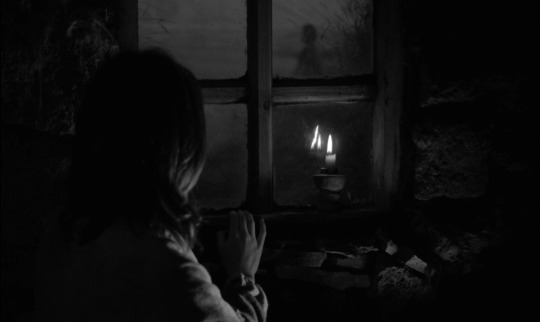
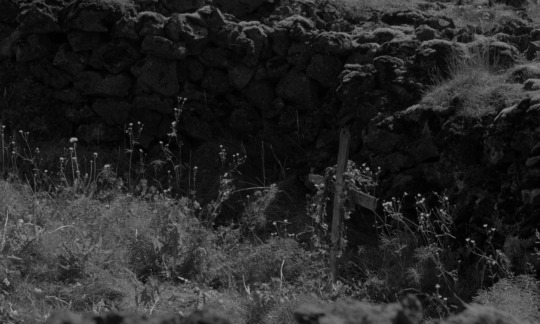


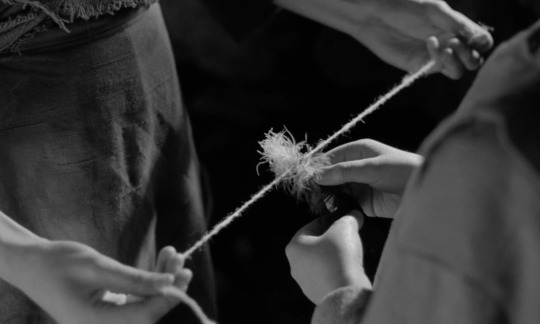

The Juniper Tree (1990) dir. Nietzchka Keene
#the juniper tree#filmedit#nietzchka keene#bjork#bryndis petra bragadóttir#valdimar örn flygenring#cinematography#black and white#films#movies#faceless
432 notes
·
View notes
Photo

The Juniper Tree
directed by Nietzchka Keene, 1990
#The Juniper Tree#Nietzchka Keene#movie mosaics#Björk#Geirlaug Sunna Þormar#Valdimar Örn Flygenring#Bryndis Petra Bragadóttir#Guðrún Gísladóttir
23 notes
·
View notes
Text
Review: Björk stars in Nietzchka Keene’s rarely seen film ‘The Juniper Tree’

Björk in the 1989 film “The Juniper Tree.” (Arbelos Films)
BY ROBERT ABELE
APRIL 16, 2019 12:27 PM PT
At the very least, watching Nietzchka Keene’s haunting Icelandic fairy tale “The Juniper Tree” can cause your sense of time to fall away. A black-and-white movie filmed in 1986, it recalls both the indie wilderness vibe of its time, yet also the monochromatic severity of early Bergman and Tarkovsky.
Heading the cast is an instantly recognizable Björk, prior to her becoming a global music phenomenon, which creates its own recontextualized aura around her. It’s also adapted from a Grimm fairy tale, yet infused with a modern feminist sensibility, and while it’s a ghostly affair with magical touches, it’s shot through with a hard-bitten realism about medieval life.
Keene didn’t complete her micro-budgeted debut feature, which she wrote, directed and edited, until 1989, after which it made the festival circuit — including the Sundance Film Festival in 1991 — but only received one Los Angeles showing, in 1990 at UCLA, Keene’s MFA alma mater. Now, 15 years after her death, in her starkly enchanting film has been given a 4K restoration, and another single-viewing chance, this time at the American Cinematheque. The opportunity is a welcome one, because Keene’s atmospheric gem deserves renewed appreciation and fresh discovery.
After finding a dead woman floating in a creek, stoned and drowned as a witch, waif-like Margit (Björk) and her pragmatic older sister Katla (Bryndis Petra Bragadóttir) must flee to avoid the same fate, which also claimed their mother. Stern widowed farmer Johan (Valdimar Örn Flygenring) takes them in, but his suspicious son Jonas (Geirlaug Sunna Þormar) — who visits his mother’s grave every day, like a dutiful son trying not to be forgotten — sees in Katla a family interloper practicing the dark arts.
He’s not entirely wrong, in that Katla believes in sorcery, but she’s also a persecuted woman in a harsh time trying to secure protection for herself and Margit — her seduction spells are born out of a desire to bind Johan to her, which she comes to realize would best be achieved with a pregnancy.
Jonas tries to turn his father against Katla, even though he isn’t so fearful of kindly, concerned Margit, and the young pair bond over their respective grief. But when Margit begins seeing visions of her dead mother — a silent, beckoning figure with a black hole in her chest — Jonas’ dislocation intensifies, until he feels the need to confront his stepmother at the most unwise of moments.
Those familiar with the original fairy tale will know where this is headed. Keene’s retelling preserves certain morbid details but alters others, so that a story steeped in misogyny and the supernatural can still resonate as a warning of the damaging ripple effects when desperation, displacement and mourning collide.
Stylistically, the movie is a stroll of otherworldly delirium, like a hybrid of Dreyer’s asceticism and the the chillier reveries in “The Night of the Hunter.” There’s austere beauty in cinematographer Randy Sellars’ rendering of the craggy, unforgiving Icelandic landscape, and for the memorable hypnagogic passages that occasionally fold over Margit’s reality, Keene enlisted acclaimed avant-garde director and optical effects guru Pat O’Neill.
Folk tales are how cultures make sense of the world, of how people changed and fates were secured. Keene fully grasps this, which is why she often has Björk’s Margit turning the details of the story she’s observing around her — hovering birds, a tended grave, her own loss, a boy’s worry, a woman’s desire — into a fanciful yarn she’s constantly spinning and revising. And Björk’s turn is a delicate, inviting thing, that innocent croak of a voice like some bridge between the mystical appeal of fairy tales and the cold truth about what human beings do when reason leaves them.
Keene made only a couple of films in her abbreviated life, but “The Juniper Tree” is absorbing enough to make one rue there weren’t more. But we can at least note for the history books that for all the hype Lars von Trier received for casting Björk in 2000’s “Dancer in the Dark,” a female filmmaker recognized her eccentric on-screen blend of mystery, humanity and guilelessness first.
#Björk#Björk Guðmundsdóttir#The Juniper Tree#Bryndis Petra Bragadóttir#Guðrún Gísladóttir#Valdimar Örn Flygenring#Geirlaug Sunna Þormar#Patrick Moyroud#Nietzchka Keene#Iceland#Quando Éramos Bruxas#Quand nouEinitréð#s étions sorcières#ビョークの「ネズの木」 グリム童話より#Krzew jałowca#Можжевеловое дерево#Cuando fuimos brujas#Ardıç Ağacı#Seljalandsfoss Waterfall#Larry Lipkis#Los Angeles Times#LA Times
1 note
·
View note
Text
Searching for the past memories
Article written for Morgunblaðið by Sveinn Haraldsson on the 6th of October 2001: https://www.mbl.is/frettir/innlent/2001/10/06/leitad_til_lidinna_tima/

From the National Theater's update of the play Water of Life. Morgunblaðið/Jim Smart
The National Theater Water of life Author: Benóný Ægisson Director: Þórhallur Sigurðsson Music: Vilhjálmur Guðjónsson Lighting: Páll Ragnarsson Costumes: Filippía I. Elísdóttir Casting: Þórunn Sigríður Þorgrímsdóttir Actors: Anna Kristín Arngrímsdóttir, Atli Rafn Sigurðarson, Áslákur Ingvarsson, Edda Arnljótsdóttir, Gunnar Eyjólfsson, Guðmundur Ingi Þorvaldsson, Hjalti Rögnvaldsson, Jóhann Sigurðarson, Jón Páll Eyjólfsson, Kjartan Guðjónsson, Margrét Guðmundsdóttir, Marta Nordal, Nanna Kristín Magnúsdóttir, Randver Þorláksson, Sigurbjartur Sturla Atlason, Snæfríður Ingvarsdóttir, Stefán Karl Stefánsson, Tinna Gunnlaugsdóttir, Valdimar Örn Flygenring, Valur Freyr Einarsson, Þórunn Lárusdóttir and Þröstur Leó Gunnarsson.
Friday 5th of October. It has been over twelve years since Benóný Ægisson won the first prize for the children's play Töfrasprotann in a play competition, which was held by Leikfélag Reykjavíkur, and had his first work staged in a professional theater. The Sweet Life, a play with songs, also won prizes and was shown on the large stage of the Borgarleikhús. He has composed numerous other works that have been shown in author workshops, amateur theater companies or on radio and television. Water of Life is combined with the two aforementioned works to be an award-winning play, it won another award together with Under the Blue Sky by Þórarinn Eyfjörð in a play competition held by the National Theater for the institution's half-century anniversary.
The main character of the play, a young man, comes home from abroad and wants to make progress to improve the interests of the country and the nation, and the author relies on historical sources to some extent. This young man has a very fragile personality and his temperament and thirst for alcohol are the most interesting aspects of his work. He may never have been able to carry out his dreams if he were unlikely to get the full support of those in power.
In addition, there are two other interpretations: that his plans came to naught due to the incompetence of the rulers or that the main character's lack of temperament caused both the public and the authorities to lose faith in him and what he wanted to achieve. It is as if the author wants to convey all this and does not take a position on which understanding is the most correct. This is an interesting subject, but it does not end there.
It is inevitable to think about the author's influences in a work where so many things are familiar. Some of the scenes have a lot to do with elements from the nation's classic literature or folklore. E.g. the scene on the flying carpet undeniably picks up various things in Jóhann Sigurjónsson's Magic Loft; the description of the city of the future is reminiscent of Arnalds' vision for the future in Sölka Völka by Halldór Laxness; the setting has countless sisters in folktales and the sisters-in-law on Brú and the older people in the town as well as the aquarians are well-known clichés from literature from the end of the nineteenth century and the beginning of the twentieth. The costumes still promote this image of the characters, they give an exaggerated picture of the difference between people and the general public, older citizens wear light lace and hyaline but the public wears dark waders.
The work is characterized by a quick review of the story and no stopping to give the audience an opportunity to think about the material completely or to get to know the characters better. Instead, half-baked portraits of the actors who are very different in their quality of life are created.
It is inevitable to wonder what the models of the work are in terms of form. It is most reminiscent of the various plays of Icelandic novels that have dominated theater life in Iceland in recent decades. There is often an attempt to get a lot done in the shortest possible time, many characters and countless things are pushed into the narrow framework of the stage work and i.e. go over history quickly, especially if nothing can be left out. The result here is a fragmentary story where the attention is spread too widely and the character creation becomes too superficial for that.
On the other hand, many things are done professionally, the director offers many ingenious play solutions, which often divert the mind from what the author wants to achieve. In a work that is about a character who loses everything due to temperament defects, ie. a typical protagonist in a tragedy, the director decides to make the most of the ironic aspects of the work. It often succeeds but diminishes its power and the message goes above and beyond the fence.
Stefán Karl Stefánsson is in the lead role here, a young actor who has become nationally known for his talents in comedy in just a few years. He cleverly manages to make Illugi a ridiculous stuntman, but fails to interpret his mental anguish when it comes to the rough. Atli Rafn Sigurðarson is ambiguous in the role of his brother Sigurður, he doesn't know whether he should make him a more cunning character or look for a deeper goal and does neither. Compared to them, Nanna Kristín Magnúsdóttir and Jón Páll Eyjólfsson are always credible as Ásta and Ingólfur, Illugi's friends who stand alone with him when the valley hardens, Nanna Kristín achieves incredible empathy in her interpretation of the long-suffering pauper. The children who played the brothers and Ásta when they were young, did a very good job.
smaller roles, various actors took to the air and created fun portraits from the past. These include Margrét Guðmundsdóttir as Gunna's maid, Edda Arnljótsdóttir, Þröst Leó Gunnarsson and Gunnar Eyjólfsson as water carriers. The older characters were much stiffer from the author's point of view and the jokes more predictable. Thus it can hardly be said otherwise than that Tinna Gunnlaugsdóttir, Valdimar Örn Flygenring, Marta Nordal, Jóhann Sigurðarson, Hjalti Rögnvaldsson, Randver Þorláksson, Kjartan Guðjónsson and Guðmundur Ingi Þorvaldsson searched for ancient paths in the creation of the character.
It is one thing to pick up its subject matter until the end of the nineteenth century; it is another that the starting point is from the same period. All originality is missing here, both from the author's and the director's. Here, everything is as traditional as can be - except for the set, which is a futuristic play in terms of shapes and colors. If the play had been premiered a hundred years ago, it would have been newsworthy.
The only message it has to modern audiences is perhaps to remind them how little their taste has changed since complaints were made about Danish song milk on the town's program list at the beginning of the last century. As the first play to be premiered on the big stage of the National Theater in the first year of a new millennium, it is surprising.
Sveinn Haraldsson
3 notes
·
View notes
Photo
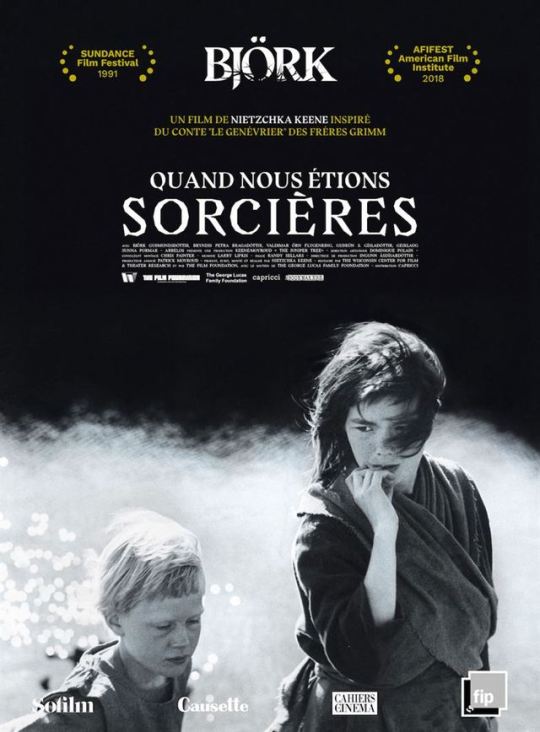
"Quand Nous Etions Sorcières" de Nietzchka Keene (1989) - inspiré du conte le "Genévrier" des frères Grimm (1812) - avec Björk, Bryndis Petra Bragadóttir, Valdimar Örn Flygenring et le petit Geirlaug Sunna Þormar, mai 2019.
1 note
·
View note
Photo



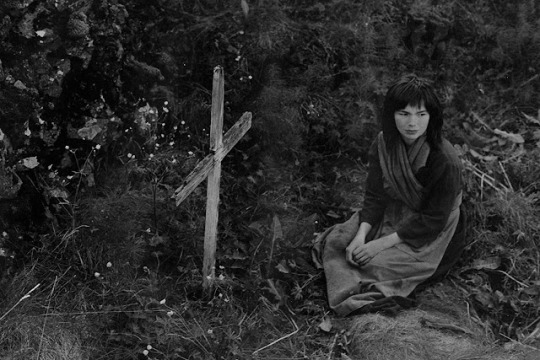
The Juniper Tree (Nietzchka Keene, 1990) Cast: Björk, Bryndis Petra Bragadóttir, Valdimar Örn Flygenring, Guðrún Gisladóttir, Geirlaug Sunna Þormar. Screenplay: Nietzchka Keene. Cinematography: Randolph Sellars. Art direction: Dominque Polain. Film editing: Nietzchka Keene. Music: Larry Lipkis. Nietzchka Keene's The Juniper Tree, the first feature in her sadly brief career, reminded me of films by Bergman and Dreyer, largely because of its bleakly beautiful, isolated, apparently medieval setting. It has also been called "feminist," a label often pasted on films directed by women, though I think it transcends labels and influences, working its effect largely through the strength of some well-imagined characters. The sisters Margit and Katla have been left homeless after their mother was burned as a witch, so Katla, the elder, casts a spell on Jóhann, a handsome young widower, and the sisters go to live with him. Jóhann's young son, Jónas, resents his stepmother and lovingly tends his mother's grave, a devotion that only feeds his animosity toward Katla, though he makes friends with Margit, who has visions of her own late mother. Eventually, as in all such tales, tensions, fed by Katla's witchcraft, Margit's visions, and Jónas's resentment, result in calamity. It's a simple story with roots in a tale from the Brothers Grimm, given potency by good performances, particularly Björk as the pivotal character of Margit, by a strong eroticism in the relationship of Katla and Jóhann, and by the exploration of the Icelandic setting in Randolph Sellars's handsome black-and-white cinematography.
0 notes
Text
The Juniper Tree - Nietzchka Keene (1990)

"The Juniper Tree is a 1990 Icelandic black-and-white medieval fantasy drama film directed and written by Nietzchka Keene. Based on the fairy tale 'The Juniper Tree' collected by the Brothers Grimm, it stars a small cast of five actors: Björk, Bryndis Petra Bragadóttir, Guðrún Gísladóttir, Valdimar Örn Flygenring and Geirlaug Sunna Þormar. The Juniper Tree is set in Iceland and portrays the story of two sisters, Margit (Björk Guðmundsdóttir) and her elder sister Katla (Bryndis Petra Bragadóttir), who escape their home after their mother (Guðrún Gísladóttir) is stoned and burned for witchcraft. They go where no one knows them, and find Jóhann (Valdimar Örn Flygenring), a young widower who has a son called Jónas (Geirlaug Sunna Þormar). Katla uses magical powers to seduce Jóhann and they start living together. Margit and Jónas become friends. However, Jónas does not accept Katla as his stepmother and tries to convince his father to leave her. ..."
Wikipedia
W - The Juniper Tree (fairy tale)
W - Nietzchka Keene
NY Times - ‘The Juniper Tree’ Review: A Young Björk Enchants in Her Film Acting Debut (Video)
The Juniper Tree - Jacob and Wilhelm Grimm
YouTube: The Juniper Tree | Trailer, Interview with Nietzchka Keene the writer-director of "The Juniper Tree"

0 notes
Video
vimeo
Whale Valley (2013) 15 min | Short, Drama, Family
The film shows a strong bond between two brothers that live in a remote fjord with their parents. We look into their world through the eyes of the younger brother and follow him on a journey that marks a turning point in the lives of the brothers.
Director: Guðmundur Arnar Guðmundsson Writers: Guðmundur Arnar Guðmundsson, Guðmundur Arnar Guðmundsson Stars: Ágúst Örn B. Wigum, Einar Jóhann Valsson, Valdimar Örn Flygenring
#Whale Valley#Guðmundur Arnar Guðmundsson#Hvalfjörður#short film#short movie#short#shortfilm#shortmovie#kısa film#kısafilm#kısa#film#movie#drama#dram#family#brothers#fjord#parents#suicide#iceland#icelandic#video#vimeo#staff pick#staff picks#suicide attempt#farmer#beach#whale
1 note
·
View note
Text
New Trailer for Restored Re-Release of 'The Juniper Tree' with Björk
"Out from here, away be gone." Arbelos Films has debuted a new trailer for the restored re-release of The Juniper Tree, a surrealist film from 1990 filmed in Iceland and made by filmmaker Nietzchka Keene. The film stars a young Björk (25 years old at the time) as a woman who flees her homeland in Iceland after her mother is killed for practicing witchcraft. Her older sister casts a spell on a farmer which makes him fall in love with her, but his son sees through her tricky plan. The full cast includes Bryndis Petra Bragadóttir, Valdimar Örn Flygenring, Guðrún Gísladóttir, and Geirlaug Sunna Þormar. This 4K restoration is from the Wisconsin Center for Film & Theater Research and The Film Foundation, with funding from the George Lucas Family Foundation. The Juniper Tree is described as a "potent allegory for misogyny and its attendant tragedies, [and] a major rediscovery for art house audiences." It seems very dreamlike and poetic. ›››
Continue Reading New Trailer for Restored Re-Release of 'The Juniper Tree' with Björk
from FirstShowing.net https://ift.tt/2SUUIFl
0 notes
Video
vimeo
WHALE VALLEY from Join Motion Pictures on Vimeo.
"Whale Valley" is this week's Vimeo Staff Pick Premiere. Read a Q&A with director Guðmundur Arnar Guðmundsson here: vimeo.com/blog/post/staff-pick-premiere-whale-valley
2013 | 15′ | short fiction | HD | 1:1.85 | Icelandic | color
Written & Directed by Guðmundur Arnar Guðmundsson
Whale Valley world premiered in the Official Competition of the 66th Cannes Film Festival 2013 were it won a Special Mention. Since then it has won over 50 international awards and received numerous nominations.
SYNOPSIS The film shows a strong bond between two brothers that live in a remote fjord with their parents. We look into their world through the eyes of the younger brother and follow him on a journey that marks a turning point in the lives of the brothers.
CAST & CREW Ívar: Ágúst Örn B. Wigum Arnar: Einar Jóhann Valsson Father: Valdimar Örn Flygenring Mother: Unnur Ösp Stefánsdóttir Farmer: Júlíus Sigmar Konráðsson
Producers: Anton Máni Svansson, Guðmundur Arnar Guðmundsson Co-Producers: Darin Mailand-Mercado, Jacob Oliver Krarup, Rúnar Rúnarsson Executive Producers: Kristinn Þórðarson, Magnús Viðar Sigurðsson, Kjartan Þór Þórðarson
Director of Photography: Gunnar Auðunn Jóhannsson Editor: Anders Skov Sound Designer: Gunnar Óskarsson Art Director: Júlía Embla Katrínardóttir Set Decorater: Freyja Vals Sesseljudóttir Costume Designer: Helga Rós V. Hannam Costumer: Arndís Ey Eiríksdóttir Make-up Artist: Alma Ösp Arnórsdóttir Assistant Director: Valgeir Gunnlaugsson Script Supervisor: Jesper Vidkjær Rasmussen Assistant Camera: Goði Már Guðbjörnsson 2nd Assistant Camera: Atli Kristófer Pétursson Key Gaffer: Geir Magnússon Gaffer: Sigurður "Bahama" Magnússon Key Grip: Viktor Davíð Jóhannsson Grip: Anton Smári Gunnarsson Sound Re-Recording & ADR Mixer: Huldar Freyr Arnarson Sound Recordist: Björn Viktorsson Best Boy: Erlendur Sveinsson Art Department Assistants: Ottó Gunnarsson, Sonja Björk Ragnarsdóttir, John Ingi Matta Catering: Daði Jónsson, Álfrún Gísladóttir VFX: Gunnar Karlsson with GunHil, Þorvaldur S. Gunnarsson SFX: Haukur Karlsson Colorist: Hannibal Lang Music in film - "Bein leið" - Written by Kristján Kristjánsson and Performed by KK Band in 1992
Produced by Join Motion Pictures in co-production with Sagafilm & Fourhands Film Supported by The Danish Film Institute / Filmworkshop, The Youth in Action Programme in Denmark, The Culture Council of West Iceland and The Icelandic Film Centre.
Follow the film --> facebook.com/whalevalley Follow the company --> facebook.com/joinmotionpictures Follow the 1st feature film from director --> facebook.com/heartstonethemovie
Contact: [email protected]
0 notes
Video
vimeo
WHALE VALLEY from Join Motion Pictures on Vimeo.
"Whale Valley" is this week's Vimeo Staff Pick Premiere. Read a Q&A with director Guðmundur Arnar Guðmundsson here: vimeo.com/blog/post/staff-pick-premiere-whale-valley
2013 | 15′ | short fiction | HD | 1:1.85 | Icelandic | color
Written & Directed by Guðmundur Arnar Guðmundsson
Whale Valley world premiered in the Official Competition of the 66th Cannes Film Festival 2013 were it won a Special Mention. Since then it has won over 50 international awards and received numerous nominations.
SYNOPSIS The film shows a strong bond between two brothers that live in a remote fjord with their parents. We look into their world through the eyes of the younger brother and follow him on a journey that marks a turning point in the lives of the brothers.
CAST & CREW Ívar: Ágúst Örn B. Wigum Arnar: Einar Jóhann Valsson Father: Valdimar Örn Flygenring Mother: Unnur Ösp Stefánsdóttir Farmer: Júlíus Sigmar Konráðsson
Producers: Anton Máni Svansson, Guðmundur Arnar Guðmundsson Co-Producers: Darin Mailand-Mercado, Jacob Oliver Krarup, Rúnar Rúnarsson Executive Producers: Kristinn Þórðarson, Magnús Viðar Sigurðsson, Kjartan Þór Þórðarson
Director of Photography: Gunnar Auðunn Jóhannsson Editor: Anders Skov Sound Designer: Gunnar Óskarsson Art Director: Júlía Embla Katrínardóttir Set Decorater: Freyja Vals Sesseljudóttir Costume Designer: Helga Rós V. Hannam Costumer: Arndís Ey Eiríksdóttir Make-up Artist: Alma Ösp Arnórsdóttir Assistant Director: Valgeir Gunnlaugsson Script Supervisor: Jesper Vidkjær Rasmussen Assistant Camera: Goði Már Guðbjörnsson 2nd Assistant Camera: Atli Kristófer Pétursson Key Gaffer: Geir Magnússon Gaffer: Sigurður "Bahama" Magnússon Key Grip: Viktor Davíð Jóhannsson Grip: Anton Smári Gunnarsson Sound Re-Recording & ADR Mixer: Huldar Freyr Arnarson Sound Recordist: Björn Viktorsson Best Boy: Erlendur Sveinsson Art Department Assistants: Ottó Gunnarsson, Sonja Björk Ragnarsdóttir, John Ingi Matta Catering: Daði Jónsson, Álfrún Gísladóttir VFX: Gunnar Karlsson with GunHil, Þorvaldur S. Gunnarsson SFX: Haukur Karlsson Colorist: Hannibal Lang Music in film - "Bein leið" - Written by Kristján Kristjánsson and Performed by KK Band in 1992
Produced by Join Motion Pictures in co-production with Sagafilm & Fourhands Film Supported by The Danish Film Institute / Filmworkshop, The Youth in Action Programme in Denmark, The Culture Council of West Iceland and The Icelandic Film Centre.
Follow the film --> facebook.com/whalevalley Follow the company --> facebook.com/joinmotionpictures Follow the 1st feature film from director --> facebook.com/heartstonethemovie
Contact: [email protected]
0 notes
Video
vimeo
WHALE VALLEY from Join Motion Pictures on Vimeo.
"Whale Valley" is this week's Vimeo Staff Pick Premiere. Read a Q&A with director Guðmundur Arnar Guðmundsson here: vimeo.com/blog/post/staff-pick-premiere-whale-valley
2013 | 15′ | short fiction | HD | 1:1.85 | Icelandic | color
Written & Directed by Guðmundur Arnar Guðmundsson
Whale Valley world premiered in the Official Competition of the 66th Cannes Film Festival 2013 were it won a Special Mention. Since then it has won over 50 international awards and received numerous nominations.
SYNOPSIS The film shows a strong bond between two brothers that live in a remote fjord with their parents. We look into their world through the eyes of the younger brother and follow him on a journey that marks a turning point in the lives of the brothers.
CAST & CREW Ívar: Ágúst Örn B. Wigum Arnar: Einar Jóhann Valsson Father: Valdimar Örn Flygenring Mother: Unnur Ösp Stefánsdóttir Farmer: Júlíus Sigmar Konráðsson
Producers: Anton Máni Svansson, Guðmundur Arnar Guðmundsson Co-Producers: Darin Mailand-Mercado, Jacob Oliver Krarup, Rúnar Rúnarsson Executive Producers: Kristinn Þórðarson, Magnús Viðar Sigurðsson, Kjartan Þór Þórðarson
Director of Photography: Gunnar Auðunn Jóhannsson Editor: Anders Skov Sound Designer: Gunnar Óskarsson Art Director: Júlía Embla Katrínardóttir Set Decorater: Freyja Vals Sesseljudóttir Costume Designer: Helga Rós V. Hannam Costumer: Arndís Ey Eiríksdóttir Make-up Artist: Alma Ösp Arnórsdóttir Assistant Director: Valgeir Gunnlaugsson Script Supervisor: Jesper Vidkjær Rasmussen Assistant Camera: Goði Már Guðbjörnsson 2nd Assistant Camera: Atli Kristófer Pétursson Key Gaffer: Geir Magnússon Gaffer: Sigurður "Bahama" Magnússon Key Grip: Viktor Davíð Jóhannsson Grip: Anton Smári Gunnarsson Sound Re-Recording & ADR Mixer: Huldar Freyr Arnarson Sound Recordist: Björn Viktorsson Best Boy: Erlendur Sveinsson Art Department Assistants: Ottó Gunnarsson, Sonja Björk Ragnarsdóttir, John Ingi Matta Catering: Daði Jónsson, Álfrún Gísladóttir VFX: Gunnar Karlsson with GunHil, Þorvaldur S. Gunnarsson SFX: Haukur Karlsson Colorist: Hannibal Lang Music in film - "Bein leið" - Written by Kristján Kristjánsson and Performed by KK Band in 1992
Produced by Join Motion Pictures in co-production with Sagafilm & Fourhands Film Supported by The Danish Film Institute / Filmworkshop, The Youth in Action Programme in Denmark, The Culture Council of West Iceland and The Icelandic Film Centre.
Follow the film --> facebook.com/whalevalley Follow the company --> facebook.com/joinmotionpictures Follow the 1st feature film from director --> facebook.com/heartstonethemovie
Contact: [email protected]
0 notes
Text
Stefán Karl as Dracula in Hotel Transylvania 2 (2015)

To properly celebrate Halloween this year, I’m finally posting about this movie that Stefán Karl was in, I was able to buy a copy of it this year and waited for the best time to write about it.
In the Icelandic dub of the second Hotel Transylvania movie, Stefán Karl voiced the lead role of Dracula. It premiered in Iceland at the 25th of September of 2015. It is unclear whether he was in the first movie. But he wasn’t in the third or fourth movie. But I have confirmation that he was in the second as a lead role.
It stars other Icelandic actors other than Stefán Karl, like Sigurbjartur Sturla Atlason, Salka Sól Eyfeld, Valdimar Örn Flygenring, Jóhannes Haukur Jóhannesson, Hjálmar Hjálmarsson, Gísli Rúnar Jónsson and Margrét Eir. (Information taken from here)
Underneath is a trailer of the Icelandic dub, I was also able to buy it from this eBay seller from Russia, ʙᴜᴛ ʏᴏᴜ ᴄᴀɴ ᴀʟꜱᴏ ᴡᴀᴛᴄʜ ɪᴛ ʙʏ ᴄʟɪᴄᴋɪɴɢ ʜᴇʀᴇ.
youtube
#stefan karl stefansson#stefan karl#stefán karl stefánsson#stefán karl#hotel transylvania 2#2015#youtube
13 notes
·
View notes
Text
Cyrano de Bergerac photos of Stefán Karl
All of these photos are taken from mbl.is
The first two photos were taken by Þorkell Þorkelsson on the 22nd of December 2001

Original caption:
Cyranó elskar Roxane en nefið stóra hindrar hann í að tjá henni ást sína. Nanna Kristín Magnúsdóttir og Stefán Karl Stefánsson
Translation:
Cyrano loves Roxane but his big nose prevents him from expressing his love to her. Nanna Kristín Magnúsdóttir and Stefán Karl Stefánsson

Original caption:
Þjónn Roxane ásamt Cyranó. Sigurður Sigurjónsson og Stefán Karl Stefánsson
Translation:
Roxane's servant and Cyrano. Sigurður Sigurjónsson and Stefán Karl Stefánsson
The last two photos were taken by Ásdís Ásgeirsdóttir on the 28th of December 2001

Original caption:
LEIKLIST - Þjóðleikhúsið Berserkurinn blíði Braga þjónn CYRANO FRÁ BERGERAC Höfundur: Edmond Rostand. Leikarar: Atli Rafn Sigurðarson, Edda Arnljótsdóttir, Eygló Hilmarsdóttir, Friðrik Friðriksson, Guðmundur Ingi Þorvaldsson, Hjalti Rögnvaldsson, Inga María Valdimarsdóttir, Jón Páll Eyjólfsson, Linda Ásgeirsdóttir, Nanna Kristín Magnúsdóttir, Pálmi Gestsson, Rúnar Freyr Gíslason, Sigurður Sigurjónsson, Snæfríður Ingvarsdóttir, Stefán Karl Stefánsson, Valdimar Örn Flygenring og Valur Freyr Einarsson. MYNDATEXTI: Stefáni Karli Stefánssyni var fagnað af áhorfendum og samstarfsfólki í leikslok.
Translation:
THEATER - The National Theater The Berserker is kind to Braga, the servant CYRANO FROM BERGERAC Author: Edmond Rostand. Actors: Atli Rafn Sigurðarson, Edda Arnljótsdóttir, Eygló Hilmarsdóttir, Friðrik Friðriksson, Guðmundur Ingi Þorvaldsson, Hjalti Rögnvaldsson, Inga María Valdimarsdóttir, Jón Páll Eyjólfsson, Linda Ásgeirsdóttir, Nanna Kristín Magnúsdóttir, Pálmi Gestsson, Rúnar Freyr Gíslason, Sigurður Sigurjónsson, Snæfríður Ingvarsdóttir, Stefán Karl Stefánsson, Valdimar Örn Flygenring and Valur Freyr Einarsson. PHOTO TEXT: Stefán Karl Stefánsson was welcomed by the audience and colleagues at the end of the play.

Original caption:
Hetjuleikurinn Cyranó frumsýndur í Stærsta nef leikhússögunnar FLESTIR ættu að kannast við nefið, þetta mjög svo langa sem þekktast er á síðari tímum fyrir að hafa prýtt bæði Gerard Depardieu og Steve Martin. Færri vita kannski að nefið er aldagamalt og birtist fyrst á leiksviði í París 1887. MYNDATEXTI. Þátttakendum í sýningunni var klappað lof í lófa.
Translation:
The heroic play Cyrano premieres with The Biggest Nose in Theater History MOST people should be familiar with this nose, it's very long as it is known in recent times for having graced both Gerard Depardieu and Steve Martin. Few people know that the nose is centuries old and first appeared on the stage in Paris in 1887. PHOTO TEXT. Participants in the show were applauded.
#stefan karl stefansson#stefan karl#stefán karl#stefán karl stefánsson#2001#cyrano de bergerac (2001)#robbie rotten
1 note
·
View note